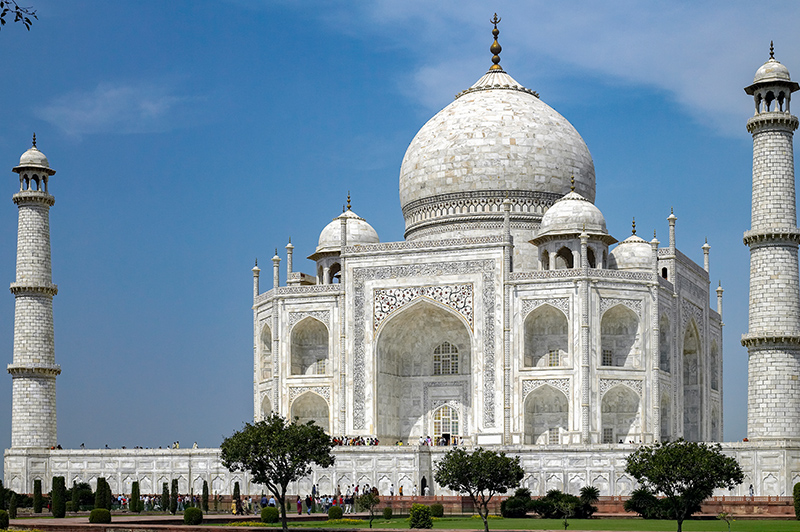Agra-Crowned by Magnificent Taj
Agra, once the flourishing capital of the Mughal Empire, is a city steeped in history and architectural grandeur. At its heart lies the Taj Mahal, a UNESCO World Heritage Site and one of the Seven Wonders of the World, celebrated for its ethereal beauty that changes hues with the shifting daylight. Beyond the Taj, Agra boasts the formidable Agra Fort, a red sandstone masterpiece that narrates tales of emperors and battles, and Sikandra, the intricately designed mausoleum of Emperor Akbar, showcasing a harmonious blend of architectural styles. Wandering through Agra’s bustling streets, visitors encounter a tapestry of ancient monuments, vibrant markets, and the lingering aroma of its famed sweet delicacies, offering an immersive journey into India’s rich past and present.

One of the Seven Wonders of the World, about 225 km from Delhi & 240km from Ranthambhore. One of the jewels of India’s rich history since 1000 B.C, the city was first referred to as ‘Agra’ by the Greek philosopher, Ptolemy in 200 A.D.
Agra- The Capital City of Mughal Empire
Agra rose to prominence in the 16th Century, as the capital of the Mughal Empire.The prominent heritage sites date back to this era, including the glorious Taj Mahal. Booming the artistic heritage of the Mughal Empire into the present day, the streets of Agra are dotted with ancient buildings existing in happy harmony with modern day shops and houses. From its fine marble inlay artwork to its delightful sweet shops, the city offers much to cherish.Representing the artistic heritage of the Mughal Empire to the present day, the streets of Agra are dotted with ancient buildings existing in happy harmony with modern day shops and houses.
Places to Visit in Agra
Taj Mahal – Among the Seven Wonders of the World: Is immortal poem in white marble is the finest expression of love of an emperor for his queen. Beauty lies in the eyes of the beholder! Probably for Taj Mahal, the axiom is just the other way round. The Taj is the beauty personified! The Taj displays its different moods through its varied shades. The Taj has as many shades as any kind of beauty can ever have! The Taj is pinkish in the morning, milky white in the evening, golden when the moon shines and the intermediary variants during different hours of the day and during different seasons in a year. Closed on Friday| Open from Sunrise to Sunset
A look at the Taj will keep you indulged with thoughts superimposing your sight and would make you feel the presence of Shah Jahan, the Maker and Mumtaz Mahal. Its breath-taking splendour makes you wonder breathlessly and you tend to pause for a while but to continue staring at ‘The Taj’, you would sense them standing beside you!
Come to ‘The Taj’ and fall in love, every time!!!

Agra Fort: Located on the right bank of the river Yamuna. This magnificent fort is robustly built and was stronghold of the Mughals, richly decorated buildings incorporating the Mughal style of art and architecture. It was constructed by the third Mughal emperor Akbar on the remains of an ancient site known as Badalgarh, in 1558. He renovated the fort with red sandstone. Some 4000 builders daily worked on it and it was completed in 8 years (1565-1573).
The fort, semi-circular on plan, is surrounded by a 21.4 m high fortification wall. Double ramparts have been provided here with broad massive circular bastions at regular intervals. There are four gates on its four sides, one of the gates was called “khizri-gate” (the water gate) which opens to the river front, where ghats (quays) were provided .The fort has survived through the onslaught of time, nature and men. The fort spreads over an area of about 94 acres of land. At present, there are more than two dozens of monuments in the Fort.Shah Jahan, a great builder, raised white marble palaces here. He also built three white marble mosques in it: Moti-Masjid, Nagina-Masjid and Mina-Masjid; was imprisoned by his son Aurangzeb.
Sikandra: The mausoleum of Akbar, himself started construction of this beautiful monument. This structure has a perfect blending of Hindu, Christian, Islamic, Buddhist, Jain themes.The decoration on the gateways is strikingly bold, with large mosaic patterns set into it. The gateway’s four minarets rising from the corners are particularly striking. Built of red sandstone, the minarets are inlaid with white marble polygonal patterns; the pleasing Proportions &Profuse surface ornamentation makes the gateways very impressive.

These gateways reflect a curious hybrid of different styles of architecture-Hindu, Muslim Christian and a patent mixture of Akbar’s typical style. A broad paved causeway lead to the tomb, which has five storeys and is in the shape of a truncated pyramid.
This is a must visit place for all those who want to experience an environment of ultimate serenity and peace. The outlaying garden which is laid out in the Char Bagh style is yet another attraction of the place. The tomb of Mariam, Jehangir’s mother, is also located close to the imposing red sandstone building.
